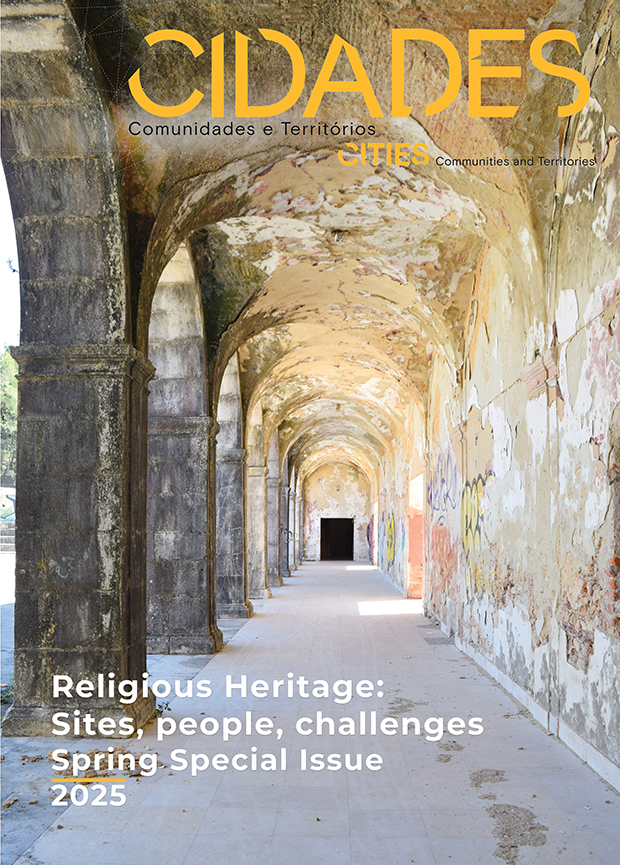Sacred Vaulted South: Proposing GIS-powered vaults cluster analysis and cultural itineraries into religious heritage buildings
Propondo análise de cluster de abóbadas e itinerários culturais em edifícios de património religioso baseado em GIS
Keywords:
Religious architecture, Vaults and domes, Southern Portugal, GIS itineraries, Vaulted South PlatformAbstract
In the south of Portugal, brick vaults are a particular traditional building system for ceilings, floors and terraces, using local materials and techniques, presently viewed as an example of sustainable construction. It was applied in various building typologies, from dwellings to religious buildings (churches, chapels, monasteries and convents), ranging from erudite to popular contexts.
Vaulted buildings carry material and immaterial values related to traditional craftsmanship, knowledge transmission and religious practices, with heritage value and the potential to be a target of fruition by local people and visitors, playing an important role in the regeneration of the hinterland areas.
This paper aims to present the potential of vernacular vaulted religious buildings to foster a sustainable territorial development empowered using digital tools in cultural tourism, promoting their understanding, dissemination and exploration among academic experts and the general public, as well as to reinforce the need for their further recovery, use and reuse.
This study was conducted under the scope of the research project Vaulted South – Vernacular vaulted houses in south of Portugal, focusing on an inner sub-region of Southern Portugal, Baixo Alentejo, and it is based on the data collected during the census of vaulted buildings settled in the regions of Portel, Moura and Serpa, as pilot case studies. Georeferenced data were handled into a GIS environment for statistical analysis and the development of thematic itineraries. First results promoted a deeper knowledge about vaulted buildings and the creation, transfer and discussion of their potential knowledge and cultural values.
References
Amaral, F. K. (coord.). (1961). Arquitectura Popular em Portugal. Lisboa: Sindicato Nacional dos Arquitectos.
Bogacz-Wojtanowska, E., Góral, A. (2018). Networks or Structures? Organizing Cultural Routes Around Heritage Values. Case Studies from Poland. Humanistic Management Journal 3, 253–277). https://doi.org/10.1007/s41463-018-0042-1
Brown, K.J.(ed.). (2020). The Routledge companion to digital humanities and art history. New York: Routledge.
Caldas, J.V. (2007). A Arquitectura Rural do Antigo Regime no Algarve [Doctoral Dissertation, Universidade de Lisboa - Instituto Superior Técnico].
Costa, S. (2024). As abóbadas das casas de Serpa: apontamentos sobre a arquitectura abobadada de tijolo no baixo Alentejo [Master Dissertation, Universidade de Lisboa - Instituto Superior Técnico].
Council of Europe. (n.d.). The future for religious heritage: Strategy 21 factsheet. https://rm.coe.int/strategy-21-factsheet-the-future-for-religious-heritage/168093c039
De Fino, M., Bruno, S., and Fatiguso, F. (2022). Dissemination, assessment and management of historic buildings by thematic virtual tours and 3D models. Virtual Archaeology Review, 13 (26), 88–102. https://doi.org/10.4995/var.2022.15426
European Commission. (2022). Cultural Tourism in Europe.
Fauzi, C., Novianti, S., and Septyandi, C. B. (2022). Combating Overtourism: The Use of Web-GIS in Visualizing Tourist Distribution and Travel Patterns. Journal of Tourism Sustainability, 2(2), 79-87. https://doi.org/10.35313/jtospolban.v2i2.44
Joyeux-Prunel, B. (2020). Digital Humanities for spatial, global, and social History of Art. In K.J.Brown (Ed.), The Routledge companion to digital humanities and art history. New York: Routledge, 88-108.
Kubler, G. (1972). A arquitectura portuguesa chã. Lisboa: Vega.
Matos, F. M. (2008). Igreja e Convento de Nossa Senhora do Carmo. In Á. D. de Almeida, and D. Belo (Eds.), Portugal Património, IX, 44. Beja, Faro: Círculo de Leitores.
Pacheco, M., Falcão, A. P., Gomes, M. G., Volzone, R., Folgado, M. P., and Costa, S. (2025). Digital Vaulted Territories: Development of a Cross-tool Platform for Vaults’ Knowledge. Revista de História da Arte. IHA - FCSH NOVA.
Pacheco, M., and Conceição, M. T. (2024). Vaulted South – Vernacular vaulted houses in South of Portugal. FCSH NOVA, http://doi.org/10.54499/EXPL/ART-DAQ/0171/2021
Pacheco, M. (2018). Fuzeta: um núcleo urbano piscatório singular.[Doctoral dissertation Universidade de Lisboa].
Reis, H., and Chicó, M.T. (1989). A Arquitectura religiosa do Alto Alentejo na segunda metade do século XVI e nos séculos XVII e XVIII. Lisboa: Imprensa Nacional-Casa da Moeda.
Richards, G. (2018). Cultural Tourism: A Global Perspective. New York and London: Routledge.
Rosado, A. (2022). A casa tradicional urbana no Alentejo: Tipos, tempos e materiais. Universidad de Sevilla / CAM/CEAACP CEAACP/FCT/Campo Arqueológico de Mértola. https://doi.org/10.14195/2184-7193_4_7
Silva, J.C.V. (1989). O Tardo-gótico em Portugal. A Arquitectura no Alentejo. Lisboa: Livros Horizonte.
Smith, M. K. (2009). Issues in Cultural Tourism Studies. New York: Routledge.
Volzone, R., Niglio, O., and Becherini, P. (2022). Integration of knowledge-based documentation methodologies and digital information for the study of religious complex heritage sites in the south of Portugal. Digital Applications in Archaeology and Cultural Heritage, 24, e00208, ISSN 2212-0548. https://doi.org/10.1016/j.daach.2021.e00208
Volzone, R., Genin, S., Estêvão, J., and Patuleia, M. (2022). Reuse of unoccupied religious monuments for tourist accommodation: Santa Maria da Ínsua (North of Portugal). In O. Niglio, and R. P. B. Singh (Eds.) Advances in Geographical and Environmental Sciences, 317-334. Singapore: Springer Nature Singapore. https://doi.org/10.1007/978-981-19-6274-5_21
Wang, X., and Wang, J. (2016). Using Clustering Methods in Geospatial Information Systems. Geomatica, 64 (3), 347-361. https://doi.org/10.5623/geomat-2010-0035
Downloads
Published
Issue
Section
License
Copyright (c) 2025 Mafalda Pacheco, Ana Paula Falcão Flor, Rolando Volzone

This work is licensed under a Creative Commons Attribution-NonCommercial-NoDerivatives 4.0 International License.
CIDADES, Comunidades e Territórios by DINÂMIA'CET-Iscte is licensed under a CC-BY licence.






